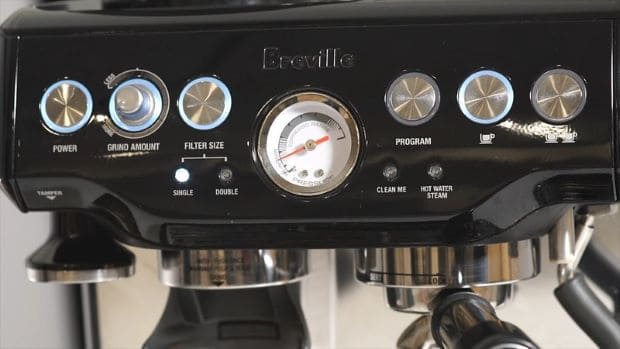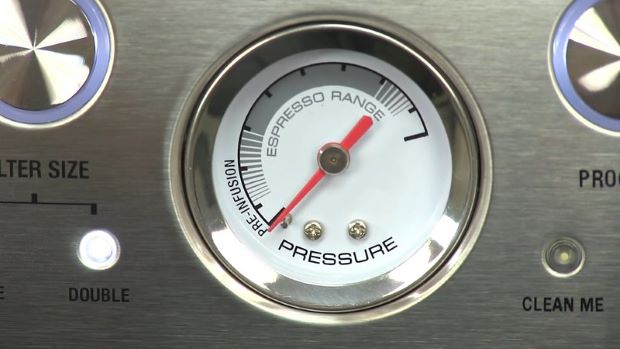Last Updated on September 2, 2024
Breville espresso machines come with a gauge that shows the water pressure as water flows through your coffee grounds.
There’s an “espresso range” marked on this gauge, and ideally the needle will be within it.
If it’s not, then the pressure is too low. The most likely reasons for this are:
- Grind is too coarse
- Not enough coffee in the filter basket
- Coffee is tamped too loosely
Those can all be easily fixed by you, the barista. Try adjusting those first, and see how it goes. If the problem persists, it may be more of a technical issue.
Technical Reasons
Beyond “barista error,” the most likely cause of a Breville espresso machine failing to reach pressure are:
- Broken pressure gauge
- Broken seal or gasket
- Clogged water line
Let’s take a look at them one-by-one.
Broken Pressure Gauge

If it’s a broken pressure gauge, then your machine might be reaching pressure just fine. You just can’t tell because the gauge is wrong.
This can happen if the mechanics inside the gauge wear out or break. Coffee lovers who use these machines often discover that this piece is the problem.
If your gauge is broken, your best bet is to take your machine to a licensed repair shop.
It’s much easier to replace a faulty gauge than it is to put in a new seal or gasket, so make sure you rule out the broken gauge before moving on to the following solutions.
Broken Seal or Gasket
Your machine has several gaskets that help its components run smoothly. They are rubber rings that prevent leaks at key connection points. Over time, they can wear down due to such things as limescale buildup and coffee oils interacting with the rubber.
Once a seal is broken, the machine has a harder time reaching pressure. You may also notice leaking from the bottom of your machine after brewing a cup of coffee.
Replacing a seal requires a visit to a licensed repair shop. If you try taking the coffee maker apart reparing it yourself, you could void the warranty.
Make sure they check all the seals, just in case more than one is cracked or leaking.
Clogged Water Line
Tap water in most locations contains a lot of minerals. If this is what you use to brew coffee, you need to descale your machine reguarly to prevent limescale buildup from these minerals.
Many coffee enthusiasts prefer to put filtered water in their machines, because filtered water doesn’t contain as many minerals as tap water.
Think of the limescale buildup like the plaque that builds up in arteries when you have too much cholesterol. It narrows the tubes and creates blockages. If water flow in your espresso machine is blocked, it could affect the pressure level. A round of descaling or two may help.
Take Care of Your Espresso Maker
When treated well, a Breville espresso machine can last for years. But it does require regular descaling and maintenance to avoid potential issues.
Thumbnail image: © Angela CoffeeRank | Creative Commons


